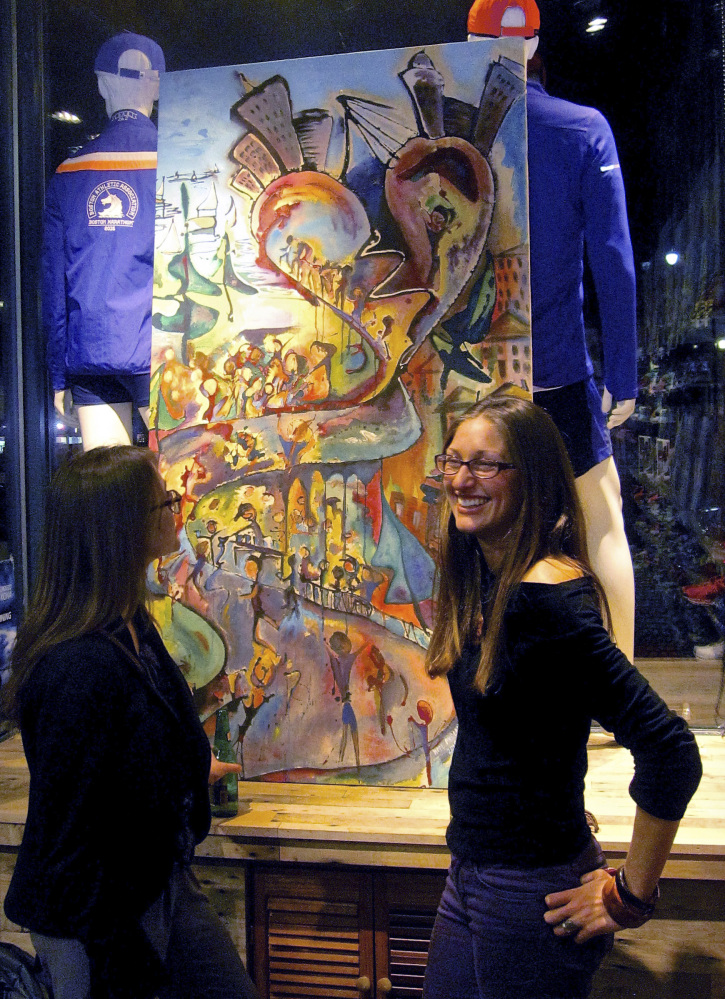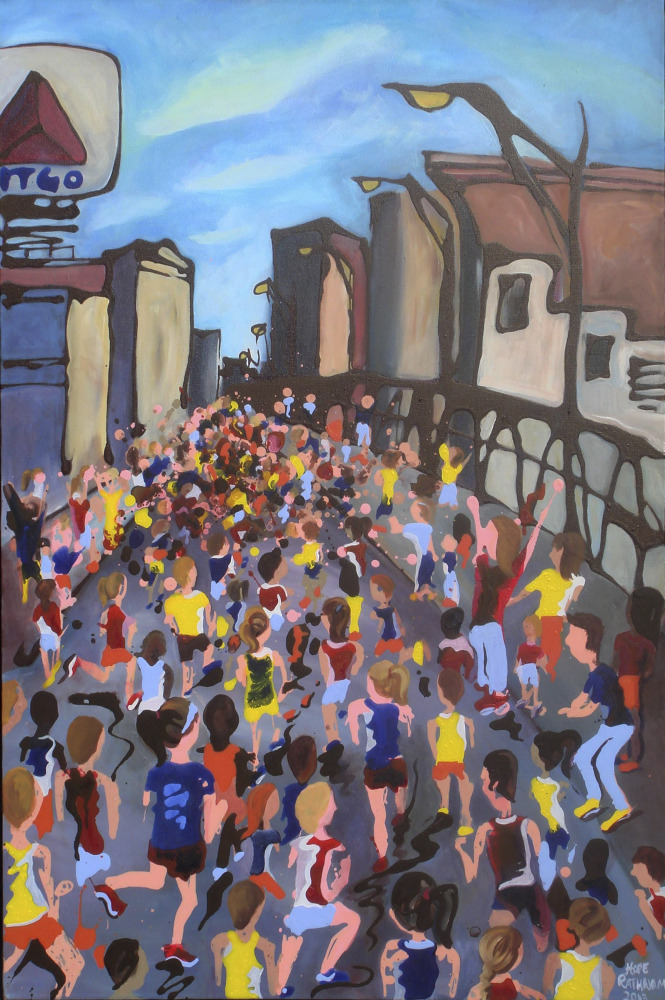BOSTON – With her running shoes and her paintbrush, Hope Phelan is trying to recapture the joy and whimsy of the Boston Marathon.
An artist and a competitive distance runner, Phelan has created a series of paintings that celebrate the race – and deliberately ignore its terrorist scars.
The women of Wellesley College offer kisses and palm slaps to passing athletes in “Wellesley Scream Tunnel.” “Heartbreak Hill” captures the euphoria that exhausted runners feel once they’ve conquered it. “The Home Stretch” shows competitors surging past Boston’s iconic Citgo sign and zeroing in on the finish line.
“I was trying to bring it back to the way I remember it. I wanted to bring the fun back,” said Phelan, 26, a professional painter and art teacher from Hingham, south of Boston, who grew up visiting every April to watch the race.
Two years after bombs killed three spectators and wounded more than 260, Phelan’s art reflects a growing desire in the running community to reclaim what America’s most beloved marathon was intended to be when it was founded 119 years ago: an amateur footrace staged purely to see who was the fastest.
“It’s a pagan rite of spring – a celebration at that time of year when there is hope again,” said Tom Derderian, a Greater Boston Track Club coach and author of “The Boston Marathon: A Celebration of the World’s Premier Race.”
“A terrible crime was committed,” he said. “But as the years go by, the Boston Marathon will be more and more of a footrace and less and less of a crime scene.”
On April 15, 2013, Phelan had finished her first Boston Marathon in just over 3 hours and was a few blocks away celebrating when she heard the explosions.
“We saw people running and screaming. It was really traumatic,” she said.
To deal with her stress, Phelan made an abstract painting she titled simply “Boston Marathon 2013”: a dark, brooding work with splashes of red acrylic reminiscent of the blood that spattered Boylston Street that day.
“I was just throwing paint at the canvas,” she recalls. “It was really emotional and expressive.”
Last year, to raise money for survivors on the anniversary of the bombings, Phelan – an expressionist plein air, or open air, painter who sells her work on Etsy under her maiden name, Hope Rathnam – was inspired to create more paintings.
But these were different: bright, colorful, playful depictions of athletes and spectators interacting along the fabled 26.2-mile course that stretches from Hopkinton to Boston.
One whimsical work, “The Finish Line,” was painted on one of the foil blankets finishers are given to keep warm. The backdrop for another is a collage of Phelan’s race bib numbers.
The paintings are being displayed through the April 20 running of this year’s race at Marathon Sports, a running shop at Mile 23 in Brookline.
“There is so much joy that leaks into the paintings that couldn’t get there any other way except for her love of running,” said Caitlin Marquis, a Boston energy policy researcher and fellow runner.
“The city is so determined to recapture the race, and these paintings are definitely in keeping with that joy,” she said.
Over the years, the Boston Marathon has outlived other efforts to co-opt it. In 1918, at the height of World War I, it was canceled and substituted with a relay race run by uniformed U.S. troops promoting patriotism and war bonds.
To marathon purists, the “Boston Strong” movement feels a little like that.
“Not to diminish the bombing, but eventually it will be one horrible incident one year in the history of the race,” said Derderian, executive producer of a forthcoming new documentary film about the venerable marathon.
Phelan, who now lives in Easthampton, hopes her art will encourage others to re-embrace its people and pageantry.
“The Boston Marathon is like a parade. People are screaming and it’s loud and there’s water being thrown at you,” she said.
“I’m hoping it’s just going to go back to normal. Because it was great before.”
Send questions/comments to the editors.




Success. Please wait for the page to reload. If the page does not reload within 5 seconds, please refresh the page.
Enter your email and password to access comments.
Hi, to comment on stories you must . This profile is in addition to your subscription and website login.
Already have a commenting profile? .
Invalid username/password.
Please check your email to confirm and complete your registration.
Only subscribers are eligible to post comments. Please subscribe or login first for digital access. Here’s why.
Use the form below to reset your password. When you've submitted your account email, we will send an email with a reset code.